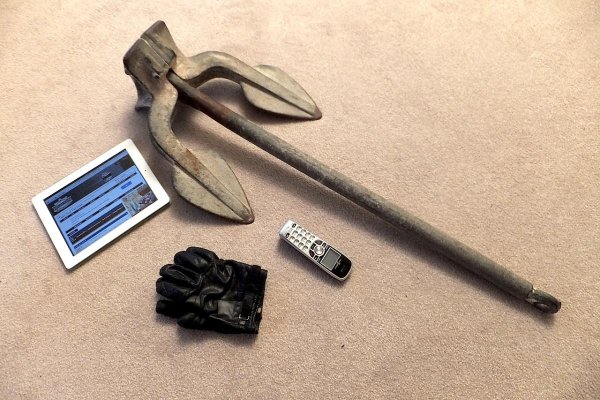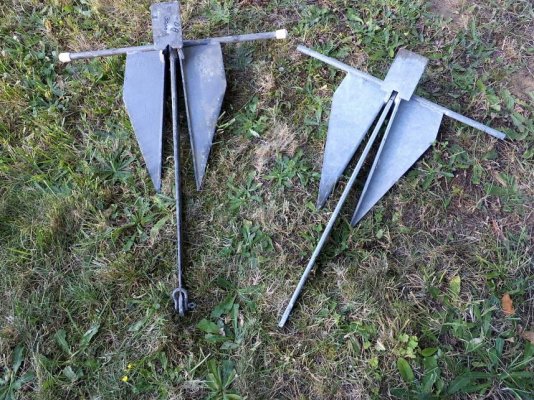Nomad Willy
Guru
How Much Chain
I’ve thought for some time that the real advantage of some chain is to help the anchor get a grip on the bottom and set. Getting the fwd end of the shank down to the sea floor is almost a must for most anchors.
Most of us have seen vids of anchors trying to set w/o any chain. The line obviously pulls the shank up (not down) and most anchors w a line rode will just skid along the sea floor w very little resistance. Steve’s vids shows a Claw doing that but most other anchors will. This can largely be avoided w a long scope but who wants to let out that much line?
Somewhere in our TF anchoring archives there’s been more than one discussion about where along the line is the weight of chain most beneficial? I think Marin Fare was involved in one that according to some scientific study w or w/o marine interest (may have had nothing to do w anchoring) that to force catenary in a line whereas one end is considerably higher than the other the point along the line is rather close to the lower end. I think the spot was determined to be about 6’ ahead of the anchor on a typical rode.
This would mean that where one would place an anchor Kellet (weight) along one’s rode would be about 6’ from the anchor. There are several ways to optimize the catenary effect.
1. Use a chain of considerable weight attached to the anchor shank about 12’ long.
2. Use a weight attached to the rode about 6’ ahead of the anchor.
3. Deploy a kellet to the rode about 6’ ahead of the anchor.
4. Tandem anchor w one anchor being about 6’ ahead of the other.
That’s about it for opitimizing the weight along the rode to maximize the amount of catenary w a given amount of rode weight.
All chain is a terrible waste of rode weight in that the upper part of the rode does little or nothing to aid catenary. If you had a 300# chain rode and changed to a combination rode of the same weight you’d have far more catenary. And according to most much more anchor performance. There are variables that would make this untrue like if you had a 1000’ chain rode. But it’s very true for most all or all anchor rodes.
So the ideal rode should be w about 12’ of chain or to make one sure for good measure .. 20 to 25’ of chain.
But most of the above is based on my recollection of something I read on TF a long time ago.
I’ve thought for some time that the real advantage of some chain is to help the anchor get a grip on the bottom and set. Getting the fwd end of the shank down to the sea floor is almost a must for most anchors.
Most of us have seen vids of anchors trying to set w/o any chain. The line obviously pulls the shank up (not down) and most anchors w a line rode will just skid along the sea floor w very little resistance. Steve’s vids shows a Claw doing that but most other anchors will. This can largely be avoided w a long scope but who wants to let out that much line?
Somewhere in our TF anchoring archives there’s been more than one discussion about where along the line is the weight of chain most beneficial? I think Marin Fare was involved in one that according to some scientific study w or w/o marine interest (may have had nothing to do w anchoring) that to force catenary in a line whereas one end is considerably higher than the other the point along the line is rather close to the lower end. I think the spot was determined to be about 6’ ahead of the anchor on a typical rode.
This would mean that where one would place an anchor Kellet (weight) along one’s rode would be about 6’ from the anchor. There are several ways to optimize the catenary effect.
1. Use a chain of considerable weight attached to the anchor shank about 12’ long.
2. Use a weight attached to the rode about 6’ ahead of the anchor.
3. Deploy a kellet to the rode about 6’ ahead of the anchor.
4. Tandem anchor w one anchor being about 6’ ahead of the other.
That’s about it for opitimizing the weight along the rode to maximize the amount of catenary w a given amount of rode weight.
All chain is a terrible waste of rode weight in that the upper part of the rode does little or nothing to aid catenary. If you had a 300# chain rode and changed to a combination rode of the same weight you’d have far more catenary. And according to most much more anchor performance. There are variables that would make this untrue like if you had a 1000’ chain rode. But it’s very true for most all or all anchor rodes.
So the ideal rode should be w about 12’ of chain or to make one sure for good measure .. 20 to 25’ of chain.
But most of the above is based on my recollection of something I read on TF a long time ago.




